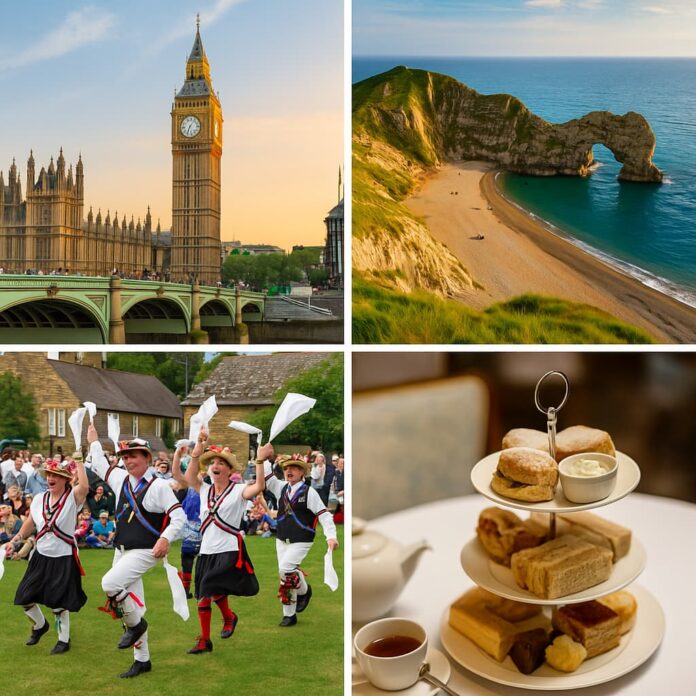The United Kingdom offers an extraordinary tapestry of landscapes, traditions, cultural landmarks, and timeless experiences. From world-class festivals and ancient monuments to the quiet charm of countryside villages, the UK presents opportunities that shape how people understand history, creativity, and community. This guide highlights eighteen essential experiences to enjoy at least once—each chosen for its ability to inspire, educate, and connect travellers to the heart of British identity in a way that is both unforgettable and deeply meaningful.
Introduction
The UK is more than a destination—it’s a living story, shaped over thousands of years by countless cultures, historic turning points, and ever-changing landscapes. Whether you are exploring the spiritual mystery of Stonehenge, admiring Georgian architecture in Bath, or walking ancient coastal paths in Cornwall, the UK invites you to discover a balance between tradition and innovation. The charm lies in the details: the warm hospitality of a village pub, the quiet hum of a heritage steam train, the vibrancy of street performers in festival season, and the tranquillity of remote Highlands.
Each region of the United Kingdom carries a distinct identity—England’s literary towns and iconic cities, Scotland’s rugged wilderness and world-renowned festivals, Wales’ mighty castles and poetic landscapes, and Northern Ireland’s dramatic geological formations. This article presents eighteen expanded experiences—each crafted with in-depth descriptions, cultural insight, practical guidance, and meaningful tips—to give readers everything they need in one place. Whether you’re planning your first visit or rediscovering the UK with fresh eyes, these moments represent the best of what the country has to offer.
1. Explore London’s Iconic Landmarks
London remains one of the world’s most influential capitals, seamlessly blending deep historical roots with modern vibrancy. Visiting its landmarks is not just tourism—it is an immersion into centuries of political evolution, architectural brilliance, and artistic excellence. From royal heritage to democratic institutions, these sites symbolise London’s role in shaping global culture. The city’s energy is unmatched, and exploring its icons helps visitors understand why London continues to capture the imagination of millions.
What You’ll Experience
You will stroll along the River Thames, passing towering landmarks such as the Houses of Parliament and Big Ben, which stand as symbols of Britain’s democratic traditions. A visit to the Tower of London reveals tales of monarchs, prisoners, and ancient rituals, while St Paul’s Cathedral showcases remarkable craftsmanship and resilience, particularly after surviving the Blitz. Walking through these sites feels like stepping through the pages of history, surrounded by bustling modern life.
Why It Matters
London’s landmarks represent layers of British identity—from medieval governance and royal lineage to religious influence and cultural innovation. Understanding these places provides valuable context for broader British history. They reveal how London transformed from a Roman settlement into a global metropolis. For visitors and locals alike, these landmarks foster appreciation for the city’s endurance, diversity, and continued global significance.
Local Tip
- Visit major landmarks early in the morning (ideally between 8–9 a.m.) to avoid queues.
- Use the Uber Boat or Thames Clippers to see the city from the river—less crowded and more scenic than the Underground.
- For photography, sunrise and sunset offer dramatic lighting on Big Ben, Tower Bridge, and St Paul’s Cathedral.
- Buy combined attraction passes if you plan to visit multiple paid landmarks.
2. Experience Edinburgh During Festival Season
Edinburgh transforms fully during its festival season, becoming an international centrepiece of performance, creativity, and cultural expression. Thousands of artists, comedians, musicians, and performers gather from around the globe, turning the city into a living stage. Each street, venue, and corner breathes with artistic energy. For anyone who appreciates culture, experiencing Edinburgh’s festivals is not simply entertainment—it is witnessing one of the most influential creative gatherings in the world.
What You’ll Experience (60+ words)
You will find yourself surrounded by street performers, comedians promoting their shows, musicians tuning their instruments on doorsteps, and artists filling makeshift venues with poetry, dance, and drama. The Edinburgh Festival Fringe is the largest arts festival on earth, offering everything from stand-up comedy to avant-garde theatre. Meanwhile, the Royal Edinburgh Military Tattoo brings unforgettable nightly performances against the dramatic backdrop of Edinburgh Castle. The atmosphere is electric, immersive, and incredibly memorable.
Why It Matters (60+ words)
Edinburgh’s festivals represent the UK’s commitment to artistic freedom, cultural exchange, and intellectual exploration. It is a place where new talent is discovered, innovative ideas are tested, and global audiences unite through creativity. The festivals shape international comedy, theatre, and art, creating a cultural legacy that stretches far beyond Scotland. Participating allows visitors to witness this creative movement at its peak, making it one of the UK’s most significant cultural experiences.
Local Tip (60+ words)
- Book accommodation 4–6 months ahead—August is extremely busy across the city.
- Explore free Fringe shows or “pay-what-you-want” performances to discover emerging talent affordably.
- Wander side streets and smaller venues for hidden gems rather than sticking to main festival hubs.
- Choose a Tattoo performance at sunset for breathtaking castle views.
3. Hike the Lake District Fells
The Lake District stands as one of Britain’s most beautiful regions, offering dramatic landscapes filled with rolling hills, serene lakes, and poetic charm. The fells—its iconic hills and mountains—define the region’s character and invite everyone from amateur walkers to seasoned hikers. Walking the fells is a wholesome experience that connects people with nature, refreshes the mind, and offers a deep sense of tranquillity far from busy city life.
What You’ll Experience
As you climb the fells, you’ll witness sweeping views of shimmering lakes, rugged peaks, and lush valleys. Popular spots like Scafell Pike, Helvellyn, and Catbells offer breathtaking panoramas that change with the weather and season. Along the trails, you may encounter sheep-dotted fields, ancient stone walls, and quiet footpaths that inspired literary giants like William Wordsworth and Beatrix Potter. Every walk feels like stepping into a living postcard of British countryside beauty.
Why It Matters
The Lake District captures the essence of Britain’s natural heritage. It has shaped poetry, art, and environmental awareness throughout the centuries. Walking its fells fosters appreciation for the landscapes that have influenced conservation movements and inspired writers, artists, and ordinary visitors for generations. It provides gentle escape from technology-driven life and encourages reflection, calmness, and a deep connection to the outdoors.
Local Tip
- Pack waterproof layers regardless of forecast—the Lake District weather changes quickly.
- Begin your hike early to enjoy quieter trails and clearer skies.
- Choose beginner-friendly routes like Catbells or Orrest Head if you’re new to fell walking.
- Finish your day in a traditional Lakeland pub for a warm meal and local ale.
4. Immerse Yourself in the Roman Baths of Bath
Bath is one of England’s most elegant and historically rich cities, combining Roman engineering, Georgian beauty, and a unique cultural identity. The Roman Baths remain the city’s centrepiece—a place where ancient rituals, architectural brilliance, and centuries of heritage converge. Walking through this site feels like stepping back in time, where echoes of Roman life can still be sensed in the steam rising from the thermal waters and the preserved stonework beneath your feet.
What You’ll Experience
Visiting the Roman Baths allows you to explore the remains of a remarkably well-preserved bathing complex used nearly 2,000 years ago. You will walk around the Great Bath, marvel at the original lead pipes, and view the Sacred Spring—the natural hot-water source that first inspired the Romans to build their spa. The museum also showcases artefacts including coins, sculptures, and curse tablets that reveal how Romans lived, relaxed, and worshipped in ancient Britannia.
Why It Matters
The Roman Baths represent a rare connection between ancient civilisation and modern British heritage. The city of Bath was shaped around this remarkable site, influencing its architecture, culture, and enduring reputation as a centre of wellness. Understanding the Baths helps you appreciate the Roman influence on early British society—from engineering methods to religious practices. It also highlights the UK’s commitment to preserving historic sites that offer invaluable insights into the country’s past.
Local Tip
- Visit early morning or late afternoon to enjoy quieter walkways around the Baths.
- Pair your visit with the rooftop pool at Thermae Bath Spa for a modern thermal bathing experience.
- Book tickets online to secure your preferred time slot—Bath often reaches capacity in peak seasons.
- Explore nearby attractions like Bath Abbey and Pulteney Bridge while you’re in the area.
5. Watch Sunrise at Stonehenge
Stonehenge is one of the world’s most enigmatic prehistoric monuments, and seeing it at sunrise enhances its mystical, spiritual atmosphere. The silhouette of the stones emerging through the first light of day is a moment that feels almost otherworldly. Whether you’re interested in archaeology, ancient religions, or atmospheric landscapes, Stonehenge at dawn offers an experience that stays with you long after your visit ends.
What You’ll Experience
Standing before Stonehenge in the early morning allows you to appreciate its scale, alignment, and sense of ancient purpose without the usual crowds. The vast Salisbury Plain stretches out in all directions, creating a peaceful setting that heightens the stones’ imposing presence. You may hear skylarks overhead or feel the chill of dawn as sunlight slowly reveals the monument’s unique structure. It is a deeply atmospheric moment unlike any other in the UK.
Why It Matters
Stonehenge is one of humanity’s most enduring mysteries. Its construction, purpose, and astronomical alignment continue to fascinate researchers worldwide. Visiting at sunrise allows you to experience the monument the way ancient people may have interacted with it, especially during solstices. It encourages reflection on early civilisation, the meaning of ritual, and the ingenuity of prehistoric engineering—reminding us how much humans achieved long before modern technology existed.
Local Tip
- Choose a “Stone Circle Access” ticket to stand closer to the stones—these sell out months in advance.
- Dress warmly; the Salisbury Plain can be windy and cold even in summer mornings.
- Arrive at least 20–30 minutes before sunrise to witness the gradual light change.
- Visit the nearby visitor centre for exhibitions that contextualise Stonehenge’s purpose and myths.
6. Drive the North Coast 500
The North Coast 500, often called Scotland’s answer to Route 66, is an extraordinary driving route along some of the most dramatic landscapes in the UK. Traversing rugged coastlines, mountain passes, remote lochs, and charming fishing villages, this 516-mile loop provides an unforgettable adventure. It is not just a scenic drive; it is a journey through Scottish identity, geography, and quiet wilderness.
What You’ll Experience
Along the NC500, you will encounter serene beaches with white sands rivaling those in the Caribbean, towering mountain ranges, and vast moorlands that seem untouched by time. Nature feels immense and ever-changing here—one minute you see rolling green hills, the next, sharp cliffs rising above deep-blue coastal waters. You will pass through historic towns, whisky distilleries, and wildlife-rich areas where deer, seabirds, and even dolphins can appear without warning.
Why It Matters
The NC500 captures the untamed spirit of Scotland, revealing landscapes shaped by ancient geology and Celtic heritage. It offers an escape from modern noise, reminding travellers of the tranquillity found in open spaces and remote communities. The route supports rural tourism, helps preserve Highland traditions, and encourages visitors to respect the natural environment. It is one of the most meaningful ways to engage with the Scottish landscape and its cultural stories.
Local Tip
- Plan fuel stops carefully—remote areas of the Highlands have long distances between petrol stations.
- Book accommodation early, especially in summer, as small towns have limited options.
- Drive slowly and respectfully on single-track roads; always use passing places properly.
- Pack layers—weather can shift from sunny to stormy within minutes in the Highlands.
7. Discover the Majestic Castles of Wales
Wales is often called the “castle capital of the world,” and visiting its fortresses is like stepping into the pages of a medieval saga. The castles here are not mere ruins—they are architectural masterpieces built by Welsh princes and English monarchs over centuries. Their dramatic settings, powerful silhouettes, and rich histories create an experience that combines beauty, storytelling, and emotional impact.
What You’ll Experience
Exploring Welsh castles such as Caernarfon, Conwy, Harlech, and Cardiff Castle immerses you in tales of battles, royal ambitions, and centuries-old power struggles. These fortresses feature soaring walls, narrow spiral staircases, massive gatehouses, and views stretching far across rugged Welsh countryside. Each castle has its own character: Caernarfon’s polygonal towers, Conwy’s riverside location, Harlech’s cliffside position, and Cardiff’s Victorian Gothic interior offer endless variety and fascination.
Why It Matters
Welsh castles are essential to understanding both the national identity of Wales and the medieval history of the British Isles. They represent eras of resistance, conquest, cultural change, and architectural evolution. Visiting them helps travellers appreciate how communities lived, fought, and survived during turbulent centuries. These castles also preserve the legacy of Welsh rulers who shaped local culture, language, and landscape.
Local Tip
- Consider purchasing a Cadw Explorer Pass to access multiple castles at a reduced cost.
- Visit early in the day to enjoy quieter ramparts and better photography conditions.
- Pair castle visits with local market towns or coastal walks for a full regional experience.
- Bring comfortable shoes—many castles involve uneven stone steps and high viewpoints.
8. Enjoy a Traditional Afternoon Tea
Afternoon tea is one of the most charming and elegant traditions in British culture. More than a simple meal, it is a leisurely ritual that symbolises hospitality, calm conversation, and refined indulgence. Sitting down for afternoon tea allows you to slow down, enjoy delicate flavours, and appreciate the nostalgic grace of British dining customs. Whether enjoyed in a luxury hotel, countryside tearoom, or quirky themed venue, afternoon tea remains an essential experience.
What You’ll Experience
A traditional afternoon tea begins with a tiered stand filled with finger sandwiches, freshly baked scones, clotted cream, strawberry jam, and miniature cakes. You will choose from a selection of teas—often loose-leaf Earl Grey, Darjeeling, or Assam—served in fine china. The atmosphere is gentle and relaxing, encouraging conversation and unhurried enjoyment. Some venues offer themed teas inspired by literary classics, royal history, seasonal flavours, or modern twists on traditional recipes.
Why It Matters
Afternoon tea is woven into British cultural identity, representing refinement, warmth, and the importance of taking time to enjoy good company. It reflects Victorian social history, when the tradition first took hold among the fashionable elite. Today, it has evolved into a comforting ritual that blends past and present. Experiencing it allows visitors to understand the British appreciation for ceremony, balance, and the quiet pleasures of everyday life.
Local Tip
- Book in advance for popular venues such as The Ritz, Claridge’s, or Fortnum & Mason in London.
- If you prefer a quieter atmosphere, choose a countryside hotel or a historic manor in the Cotswolds or Yorkshire.
- For a modern twist, try themed afternoon teas such as literary, botanical, or festive versions.
- Let the venue know dietary needs early—many offer excellent vegan, gluten-free, and nut-free menus.
9. Wander Through the Cotswolds
The Cotswolds is one of the most picturesque regions in England, known for its honey-coloured stone cottages, rolling green hills, charming market towns, and peaceful rural beauty. It offers an idyllic escape from urban life, filled with scenic footpaths, independent shops, historic churches, and cosy tearooms. Exploring the Cotswolds feels like stepping into a living postcard of timeless English countryside charm.
What You’ll Experience
You will stroll through villages such as Bibury, Bourton-on-the-Water, Stow-on-the-Wold, and Castle Combe—each with its own character and history. Expect quiet riverside paths, heritage wool churches, stone bridges, and inviting pubs with roaring fireplaces. Walks along the Cotswold Way provide views across patchwork fields and woodland. Independent bakeries, local craft shops, and farm stores add to the gentle pleasure of wandering slowly and savouring each village at its natural pace.
Why It Matters
The Cotswolds captures the quintessential image of rural England. It preserves traditions of craftsmanship, agriculture, and local architecture that have shaped British culture for centuries. Visiting teaches you about the wool trade that built the villages, the conservation efforts that protect the region, and the enduring appeal of simple, peaceful living. It is a place to reconnect with nature, history, and the quieter rhythms of life.
Local Tip
- Visit mid-week to avoid tourist crowds and enjoy emptier paths, shops, and tearooms.
- Stay overnight in a traditional inn to fully experience Cotswold hospitality.
- Use public footpaths—many of the best views are accessible only by walking.
- Bring comfortable walking shoes; roads and paths can be uneven or steep in places.
10. Explore the Giant’s Causeway (Northern Ireland)
The Giant’s Causeway is one of the most extraordinary natural wonders in the UK. Its 40,000 interlocking basalt columns were formed by volcanic activity millions of years ago, yet their geometric perfection inspired centuries of Irish folklore. Standing on this UNESCO World Heritage Site feels surreal—nature and mythology merge into a dramatic coastal landscape that leaves a powerful, lasting impression on all who visit.
What You’ll Experience
You will walk along rugged cliffs overlooking the Atlantic Ocean, hearing waves crash against the stones below. The basalt columns create unique patterns that feel almost man-made. Trails take you to viewpoints like the Giant’s Boot and Organ Pipes, each with its own story. The visitor centre offers scientific explanations and mythological tales, enhancing your understanding of both the geological formation and cultural meaning behind the landscape.
Why It Matters
The Giant’s Causeway represents the intersection of natural history and cultural storytelling. Geologically, it showcases the power of volcanic forces that shaped Northern Ireland’s coast. Culturally, it preserves legends of the giant Fionn mac Cumhaill, who supposedly built the causeway to Scotland. Visiting encourages reflection on nature’s ability to inspire imagination and scientific curiosity. It also highlights Northern Ireland’s unique landscapes and heritage.
Local Tip
- Wear strong, waterproof shoes—the stones can be slippery, especially after rain.
- Arrive early morning or late afternoon for fewer crowds and dramatic lighting.
- Explore beyond the main area; the coastal trails offer stunning, quieter viewpoints.
- Combine your visit with Dunluce Castle or Carrick-a-Rede Rope Bridge for a full day of coastal exploration.
11. Experience a Premier League Football Match
Attending a Premier League match is one of the most thrilling cultural experiences in the UK. Football is deeply embedded in British identity, and stadiums come alive with chants, passion, tradition, and a shared sense of belonging. Whether you support a team or simply enjoy sport, the energy inside a Premier League ground is unlike anything else—intense, unforgettable, and emotionally compelling.
What You’ll Experience
You will hear stadium chants echoing through the stands, see flags waving proudly, and feel the collective excitement of thousands of fans reacting to every goal, tackle, and moment of tension. The atmosphere changes dramatically depending on the rivalry, location, and stakes of the match. From historic grounds like Anfield and Old Trafford to modern arenas like Tottenham Hotspur Stadium, each venue offers its own distinct character and history.
Why It Matters
Football in the UK is more than entertainment—it reflects community spirit, local pride, and shared identity. Clubs have shaped neighbourhoods, become part of family traditions, and played roles in social change. Experiencing a match immerses you in the heart of British culture and helps you understand the emotional connection fans have with their teams. It highlights how sport can unite diverse people under a common passion.
Local Tip
- Purchase tickets only through official club websites or verified resale partners to avoid scams.
- Arrive early to soak up pre-match atmosphere and explore club museums or nearby pubs.
- Be respectful of team rivalries—wearing neutral colours is safest if you are unsure.
- Use public transport; match-day traffic makes driving extremely slow near stadiums.
12. Ride a Heritage Steam Train Through the Countryside
Riding a heritage steam train is one of the most nostalgic and enchanting experiences the UK has to offer. These beautifully restored locomotives take passengers back to a period when rail travel was slow, scenic, and deeply atmospheric. The rhythmic sound of the engine, the whistle echoing across valleys, and the countryside rolling past your window create a calm, immersive journey. It is a living tribute to British engineering, history, and railway culture.
What You’ll Experience
Onboard a heritage steam train, you’ll enjoy vintage carriages with polished wood, brass fixtures, and soft seating reminiscent of 19th-century travel. The route passes through rural landscapes, moorlands, forests, and coastal paths depending on the line you choose. Popular routes include the North Yorkshire Moors Railway, the Severn Valley Railway, and Scotland’s famous Jacobite Steam Train, known for its appearance in the Harry Potter films. The slow, steady pace allows you to absorb every detail of the scenery.
Why It Matters
Britain was the birthplace of the railway revolution, and heritage steam trains preserve that pivotal moment in global history. These journeys celebrate the craftsmanship, innovation, and cultural importance of rail travel in shaping communities and industries. Riding a steam train helps people connect with an era before digital noise—when journeys were experiential, not rushed. It keeps railway heritage alive for both enthusiasts and first-time visitors who want an authentic encounter with the past.
Local Tip
- Book seats in advance—especially for popular trains like the Jacobite.
- Choose window seats on the left side for the best views on coastal or mountain routes.
- Bring a camera; heritage stations and carriages offer beautiful photo opportunities.
- Allow extra time to explore station museums, workshops, and gift shops.
13. Visit the Historic Colleges of Oxford or Cambridge
Visiting Oxford or Cambridge is like stepping into an academic world preserved across centuries. The architecture, libraries, quadrangles, and cobbled streets reflect the brilliance of scholars, poets, scientists, and leaders educated there. Whether you wander the peaceful courtyards or explore iconic buildings, these university cities radiate intellectual history and cultural richness. A visit provides insight into how knowledge, tradition, and discovery have shaped British education for generations.
What You’ll Experience
As you explore the colleges, you’ll encounter ornate chapels, ancient dining halls, and libraries filled with priceless manuscripts. The Bodleian Library, King’s College Chapel, and the Bridge of Sighs are just a few highlights. Traditional student activities, like punting on the river, offer a charming way to experience the cities’ unique atmosphere. Museums such as the Ashmolean and the Fitzwilliam provide additional depth, housing impressive art and historical collections.
Why It Matters
Oxford and Cambridge have profoundly influenced global academia, producing groundbreaking research and generations of influential thinkers. Visiting these cities lets you trace the footsteps of literary icons, world leaders, scientific pioneers, and Nobel laureates. The beauty of the architecture and the sense of continuity contribute to a deeper appreciation of Britain’s intellectual heritage. These universities highlight the UK’s commitment to scholarship, tradition, and the pursuit of knowledge.
Local Tip
- Join a student-led walking tour—guides share insider stories and college traditions.
- Visit early in the morning for quieter courtyards and the best photography light.
- Try punting on the River Cherwell or River Cam for a classic experience.
- Some colleges charge entry fees—check opening hours and restrictions before visiting.
14. See the Northern Lights in Scotland
Although many associate the Northern Lights with Iceland or Norway, parts of Scotland offer excellent opportunities to witness this awe-inspiring natural phenomenon. The further north you travel, the clearer and darker the skies become, increasing your chances of catching the Aurora Borealis. Watching green and purple lights dance across the sky is an unforgettable experience that leaves a deep sense of wonder and connection with nature.
What You’ll Experience
On clear winter nights, you may see shimmering ribbons of colour streaking across the sky, shifting in waves that feel alive. Locations such as the Isle of Skye, the Cairngorms, and Shetland Islands offer excellent visibility with minimal light pollution. The surrounding landscapes—mountains, lochs, coastlines—enhance the experience, making it a beautifully serene and magical moment. Even if the aurora doesn’t appear, the stargazing alone is breathtaking.
Why It Matters
Seeing the Northern Lights in Scotland demonstrates the UK’s surprising natural diversity. It connects visitors to powerful atmospheric forces and ancient myths tied to the aurora. Historically, sightings were considered spiritual signs, guiding folklore in Scottish and Nordic cultures. The experience also fosters appreciation for conservation efforts, as clear, dark skies are essential for both wildlife and astronomical viewing. It’s a reminder of the rare beauty found in remote British landscapes.
Local Tip
- Use aurora forecast apps to check the KP index and cloud cover.
- Visit between October and March for the best chance of sightings.
- Choose rural locations far from artificial lighting—Shetland and Caithness are excellent.
- Dress warmly and bring a hot drink; temperatures at night drop sharply.
15. Tour Shakespeare’s Stratford-upon-Avon
Stratford-upon-Avon is a town steeped in literary heritage, best known as the birthplace of William Shakespeare. Walking through its timber-framed streets feels like travelling back to Tudor England. The town preserves sites connected to Shakespeare’s life, career, and family, offering a rich cultural experience for literature lovers and history enthusiasts. It also remains a vibrant centre for theatre, celebrating Shakespeare’s work through contemporary productions.
What You’ll Experience
You can visit Shakespeare’s Birthplace, a beautifully preserved home filled with exhibits about his childhood and early inspirations. Anne Hathaway’s Cottage offers a glimpse into rural Elizabethan life, while Hall’s Croft showcases the home of Shakespeare’s daughter. The Royal Shakespeare Theatre stages world-class performances, allowing you to see Shakespeare’s plays in the town where he grew up. Charming cafes, river walks, and markets add further enjoyment to your visit.
Why It Matters
Shakespeare is one of the most influential writers in history, and Stratford-upon-Avon preserves the places that shaped his creative genius. Visiting allows you to understand the environment that inspired his timeless works—stories still read and performed worldwide. The town demonstrates how literature, heritage, and theatre can remain deeply relevant across centuries. It is an essential destination for anyone interested in British culture or the evolution of storytelling.
Local Tip
- Book Royal Shakespeare Company tickets weeks in advance for popular productions.
- Visit early in the day to enjoy quieter museum spaces and town streets.
- Combine your visit with a boat ride on the River Avon for a peaceful experience.
- Explore beyond the main attractions—local independent shops offer unique gifts and books.
16. Walk the Coastal Paths of Cornwall
Cornwall’s coastal paths offer some of the most dramatic, inspiring, and photogenic scenery anywhere in the UK. The region is known for its rugged cliffs, turquoise waters, ancient myths, fishing villages, and ever-changing weather that transforms the coastline into a living artwork. Walking the Cornish coastline invites you to slow down, breathe deeply, and absorb landscapes shaped by centuries of wind, waves, and stories. It is a deeply enriching outdoor experience that mixes adventure, tranquillity, and discovery.
What You’ll Experience
Walking along the South West Coast Path exposes you to towering cliffs, hidden coves, white-sand beaches, and sweeping ocean views. You might pass wild ponies, seabirds, and tiny fishing harbours that feel untouched by time. Popular stretches include those near St Ives, Tintagel, Land’s End, and Porthcurno. Each turn reveals something new—rock arches, quiet beaches reached only by foot, historic lighthouses, and legends tied to Arthurian mythology and maritime history.
Why It Matters
Cornwall represents the beating heart of Britain’s coastal heritage. Walking these paths offers insight into how geography has shaped culture, livelihoods, and folklore across generations. Coastal walking promotes mindful travel, environmental appreciation, and physical wellbeing. It deepens your understanding of Britain’s maritime past—from tin mining and fishing traditions to shipwreck stories and Celtic legends. Cornwall’s coast is both wild and welcoming, showing a side of the UK that remains authentically rooted in nature.
Local Tip
- Start walks early to enjoy cooler temperatures and clearer views.
- Wear sturdy footwear—Cornish paths can be steep, rocky, or muddy.
- Bring water and snacks; remote sections often lack shops or facilities.
- Check tide times, especially if exploring beaches or cliffside routes.
17. Experience British Christmas Markets
British Christmas markets bring together festive decorations, artisan crafts, winter comfort food, and lively seasonal spirit. Whether set against the backdrop of a cathedral, a medieval town square, or a modern city centre, they offer a warm, joyful experience for all ages. Twinkling lights, mulled wine, carol singers, and handcrafted gifts create an atmosphere that celebrates tradition, community, and creativity. Visiting a Christmas market is one of the most heart-warming experiences of winter.
What You’ll Experience
You’ll wander through wooden chalet-style stalls selling handmade ornaments, candles, jewellery, toys, and local produce. The air is filled with the scent of cinnamon, roasting chestnuts, and festive treats like stollen or mince pies. Visitors can enjoy ice skating, Christmas lights displays, live choirs, and seasonal entertainment. Markets in Bath, Manchester, Edinburgh, and Winchester are among the most famous—but nearly every UK town has its own festive variation that reflects local culture.
Why It Matters
British Christmas markets celebrate craftsmanship, community, and winter traditions that bring people together. They support local artisans, encourage small businesses, and offer a space for families to create meaningful holiday memories. The markets showcase regional identities through food, music, and cultural practices, giving visitors a unique festive experience. They also reflect Britain’s history of winter gatherings, blending European influences with distinctly British charm and warmth.
Local Tip
- Visit on weekday evenings for fewer crowds and easier movement between stalls.
- Bring reusable bags—many vendors appreciate eco-friendly shoppers.
- Carry cash as some independent vendors may not accept cards.
- Check the entertainment schedule; markets often host choirs, local bands, or special themed nights.
18. Enjoy a Classic Sunday Roast
A Sunday roast is one of Britain’s most comforting and beloved traditions. It is more than just a meal—it is a weekly ritual centred around gathering, celebration, and warmth. Families, couples, and friends all come together to share roasted meats, crispy potatoes, Yorkshire puddings, vegetables, and rich gravy. The experience reflects the British love for hearty food, hospitality, and time spent with loved ones. Eating a Sunday roast is a window into everyday British culture at its most welcoming.
What You’ll Experience
You will taste perfectly roasted meats—beef, chicken, lamb, or pork—served with golden roast potatoes, seasonal vegetables, stuffing, Yorkshire puddings, and a generous amount of gravy. Many pubs offer variations, including vegetarian or vegan roasts inspired by British classics. The atmosphere is relaxed yet lively, with locals chatting over pints and families gathering for a cosy Sunday tradition. Whether enjoyed in a countryside pub or a city gastropub, a roast always feels comforting and memorable.
Why It Matters
The Sunday roast represents British culture at its core: tradition, togetherness, and nourishment. Historically, families prepared larger meals on Sundays after church, a custom that evolved into the modern roast dinner. Today, it remains a cherished ritual that brings people together across generations. Experiencing a Sunday roast connects visitors to the everyday rhythms of British life and showcases the country’s deep appreciation for simple, well-prepared food shared with loved ones.
Local Tip (Bullet Points, Expanded)
- Book tables in advance—Sunday lunchtime is the busiest time for pubs and restaurants.
- Try a countryside pub for a more authentic and atmospheric roast.
- Ask about specials; many places offer seasonal roasts or unique regional variations.
- Arrive early if you prefer a quieter dining experience.
FAQs
1. What makes the UK such a unique travel destination?
The UK stands out because it offers an extraordinary mix of history, culture, landscapes, and modern attractions within a relatively small area. Travellers can explore ancient monuments, global cities, dramatic coastlines, literary landmarks, and friendly rural villages—all within a few hours’ travel. Its blend of heritage, creativity, festivals, and natural beauty provides something for every interest. This diversity makes the UK a uniquely rich and rewarding destination for both short breaks and extended journeys.
2. When is the best time to explore the UK for outdoor activities?
Late spring (May–June) and early autumn (September–October) are ideal for outdoor activities in the UK. These seasons offer mild weather, fewer crowds, and beautiful natural scenery—perfect for coastal walks, countryside hikes, and national park adventures. Summer provides longer daylight hours but attracts heavier tourism. Winter can be atmospheric too, especially in places like the Highlands or Cornwall, though conditions vary. Ultimately, the “best time” depends on whether you prefer warmth, tranquillity, or dramatic seasonal landscapes.
3. How many days do you need to experience the UK properly?
A well-planned 10–14-day itinerary allows most travellers to enjoy a balanced introduction to the UK. This timeframe makes it possible to explore London, take day trips to historic cities, visit Scotland or Wales, and enjoy some countryside or coastal regions. However, each area—especially Scotland, the Lake District, Cornwall, and Northern Ireland—deserves longer if you want deeper experiences. Even a shorter 5-day trip can be memorable if focused on specific themes like history, nature, or culture.
4. Is the UK easy to travel around without a car?
Yes, the UK is one of the most accessible countries in the world for car-free travel. Its rail network connects major cities, historic towns, and scenic regions efficiently. Coaches offer affordable long-distance travel, while local buses reach many rural areas. In cities, walking and public transport work extremely well. Although remote regions like the Highlands or parts of Wales are easier by car, most of the UK can be explored comfortably without driving.
5. What are the must-try traditional British foods for visitors?
A classic Sunday roast is essential, along with fish and chips, Cornish pasties, afternoon tea, and English breakfast. Regional dishes—such as haggis in Scotland, Welsh rarebit, Yorkshire pudding, and Northern Irish soda bread—offer deeper insights into local culture. For desserts, try sticky toffee pudding, scones with clotted cream, or Bakewell tart. British cuisine has evolved significantly, blending tradition with modern culinary creativity, so visitors can enjoy both hearty comfort food and vibrant contemporary dishes.
6. Which UK experiences are best for families with children?
Families often enjoy castle visits, steam train rides, coastal walks, wildlife parks, and interactive museums such as the Natural History Museum or Science Museum. The Harry Potter Studio Tour is a major favourite, as are beach days in Cornwall and nature trails in the Lake District. Many UK attractions offer family passes, engaging exhibits, and child-friendly activities, making it easy to plan meaningful experiences that combine learning, adventure, and fun for children of all ages.
7. How can travellers make the most of UK cultural traditions?
The best way to enjoy UK cultural traditions is to participate in them naturally—have a Sunday roast in a cosy pub, attend a local festival, enjoy afternoon tea, visit a Christmas market, or explore historic towns on foot. Engaging with literature, theatre, music, and seasonal celebrations provides deeper insight into British life. Speaking with locals, trying regional foods, and touring heritage sites help travellers understand how culture and community shape the UK’s distinctive identity.
Conclusion
The United Kingdom is a destination full of depth, character, and unforgettable experiences. From historic landmarks and ancient sites to small villages, dramatic coastlines, and cultural festivals, each moment adds another layer to your understanding of British life. These eighteen experiences reveal the diversity and richness of the UK—showing that it is not just a place to visit, but a place to feel, explore, and connect with on a deeper level.
Whether you are discovering London’s landmarks, walking the Cornish cliffs, savouring a Sunday roast, or wandering through festive Christmas markets, each encounter reflects the country’s unique blend of history, community, and scenic beauty. The more you explore, the more the UK opens up its stories, traditions, and warm spirit. No matter how many times you return, there is always something new to experience—making the United Kingdom a timeless and endlessly rewarding destination.




























